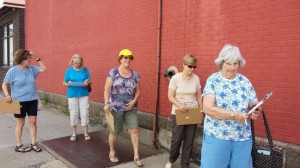By Jaime Corliss and Ben Wood, MDPH and Julie Kelly, Fall River Mass in Motion
Public health people love to talk about Policy, Systems and Environmental change (PSE for short). You probably have an understanding of what this concept means (and you may be sick of hearing about it; or if you are like us you live and love it!) but it is important to note how much this way of thinking is driving public health priority selection and resource allocation.
In short, the PSE concept means moving away from focusing on the behavior of individuals to understanding how our laws and procedures interact with the physical and social environments to create obstacles to, or support opportunities for, healthy living. We sum up this approach by saying that we want to “make the healthy choice the easy choice.”

- Senior champions assessing the walkability of Fall River. Photo by Eric Andrade
Enter Mass in Motion. Mass in Motion is an initiative of the Massachusetts Department of Public Health (MDPH) that works to create conditions in our communities that make it easier for people to be physically active and to have accessible, fresh, and healthy food. The logical partners to making lasting positive change are municipal officials.
Case in Point: Mass in Motion Fall River received a $10,000 grant as part of a collaboration between MDPH’s Mass in Motion program and the MA Association of Councils on Aging. The purpose of this grant was to identify improvements in the community that would improve the health, safety, and quality of life of Fall River seniors.
In deciding what project might benefit Fall River seniors the most, Julie Kelly, who oversees the Mass in Motion program in Fall River, met with Pauline Gousie, Director of Fall River’s Council on Aging. Pauline and Julie discussed the issues facing Fall River seniors and decided to use their $10,000 grant to improve walkability near two local senior centers, the Niagara Senior Center and the Flint Senior Center.
Walking is considered to be one of the best forms of exercise for people of all ages and delivers many health benefits while also making communities safer and more livable. In fact, most people get most of their exercise by walking. The goal of the Fall River grant was to identify barriers to walking surrounding the Niagara and Flint Senior Centers and to work with municipal leaders on street improvements that would improve walkability.
Mass in Motion and the Fall River Council on Aging knew that seniors would be the best judges on the walkability of the area surrounding their local senior centers, so they recruited a group of “senior champions.” Through training and assistance by the statewide walking advocacy organization WalkBoston, this group of seniors became skilled in identifying barriers in the physical environment that prevented safe and enjoyable walking.
Meanwhile, WalkBoston also trained and engaged the local officials critical to making improvements to the local walking environment. These officials included members of the Traffic Department, the Engineering Department, the Planning Department, and the Police Department. During this meeting, WalkBoston provided an overview of the walkability grant project and presented features of walkable communities.
With the assistance of WalkBoston, Mass in Motion, and the Council on Aging, a total of six walk audits were conducted in the area surrounding the Niagara and Flint Senior Centers (see sample report). A walk audit is a concrete way to visually assess and document barriers and facilitators in the physical environment to walking. A major finding was that there were not nearly enough crosswalks to allow seniors to easily traverse the area, and that crosswalks that were in place had been striped so long ago that they had faded and were barely visible. Restriping and adding crosswalks became a top priority and a recommendation of the senior walking advocates.
While these walk audits were in process, something interesting began happening: the Fall River Traffic Department restriped the crosswalks surrounding both centers AND continued restriping all crosswalks down the length of Pleasant Street, which is a busy roadway that runs in front of the Flint Senior Center. In addition, a meeting is planned that will bring champions face-to-face with department heads to discuss some of the other findings of the audits and make recommendations, such as posting signs, removal of overgrowth that impedes sidewalk usage, and addressing uneven sidewalks that can lead to falls, one of the greatest hazards to seniors’ health.
Julie Kelly, Fall River Mass in Motion coordinator, credits the success of this project to the power of community engagement and advocacy. Municipal officials have many demands and priorities that they are working to meet each day, but when community members take the time to educate municipal officials about community needs, officials often respond.
In this case, just the knowledge that a group of committed seniors were actively identifying barriers to walking was enough to get municipal officials to act – no debriefings necessary! So the people in need of change found the leverage point with the people with the power to make that change. The recipe for success!
You can help raise awareness of the importance of walkability for seniors and people of all ages. You can check to see if your community has a Mass in Motion coordinator in place already, or contact your local Council on Aging to help make your community safer, healthier, and happier.
